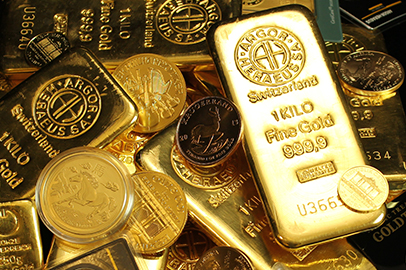Gold prices posted significant gains in both the Egyptian and global markets last week, rising by 1.4% locally and 1.2% internationally, according to a report by online precious metals platform iSagha. The increase was driven by a weakening US dollar, signs of continued monetary easing by the Federal Reserve, and escalating geopolitical tensions.
Said Embaby, CEO of iSagha, stated that the price of 21-karat gold rose by approximately EGP 70, starting the week at EGP 4,900 per gram and closing at EGP 4,970. On the international market, the price of gold surged by $42 per ounce, beginning the month at $3,643, reaching a record high of $3,707 on September 17, and ending the week at $3,685.
In the local market, 24-karat gold reached EGP 5,680 per gram, while 18-karat and 14-karat gold stood at EGP 4,260 and EGP 3,314, respectively. The price of the gold pound remained unchanged at EGP 39,760.
Globally, gold notched its fifth consecutive weekly gain, buoyed by central bank policy shifts. The US Federal Reserve’s recent 25-basis-point interest rate cut, described by Fed Chair Jerome Powell as “risk management” amid labor market pressures, contributed to the metal’s momentum.
Last week’s central bank decisions created volatility across precious metal markets. However, despite the fluctuations, gold held its gains and now appears to be at a new inflection point. Investors have begun tempering expectations of aggressive rate cuts and are instead focusing on upcoming economic indicators.
By Friday, gold was headed for its fifth straight weekly gain, maintaining an upward trend amid growing market speculation on the Fed’s next moves. The precious metal has now risen nearly 40% since the beginning of the year, marking one of its strongest annual performances since 1979.
Despite this rally, analysts have not recommended reducing gold holdings. On the contrary, Société Générale increased its gold allocation to 10% of its total investment portfolio, reflecting growing institutional confidence in gold as a safe-haven asset.
Analysts believe the current upward trend is still in its early stages. Continued global uncertainty is expected to fuel demand for gold, with some forecasts projecting prices could reach $4,000 per ounce by the end of 2025 or early 2026.
These projections are underpinned by mounting economic pressures, including soaring levels of public debt. In the US, the budget deficit has grown by $2trn this year, pushing total federal debt beyond $37 trillion. Rising debt burdens are not limited to the US, with global debt levels also climbing. This has contributed to gold reaching record highs in several major currencies, including the Canadian dollar, British pound, euro, Japanese yen, and Australian dollar—with prices exceeding CAD 5,000 per ounce.
Concerns over the Federal Reserve’s independence are also increasing, especially following recent appointments seen as favoring more accommodative monetary policies. While Powell has struck a cautious tone, markets are pricing in a 91% probability of another 25-basis-point rate cut at the Fed’s next meeting on October 29. Fed officials, including Neel Kashkari, have emphasized that future decisions will remain data-dependent, particularly on inflation and employment.
Central banks around the world are also expected to continue increasing their gold reserves, reflecting a broader shift away from reliance on the US dollar. Recent trade data revealed a sharp drop in Swiss gold exports to the US in August, attributed to new tariffs, while exports to China and India rose significantly.
Investors are now closely watching key upcoming data, including global PMI figures, durable goods orders, US unemployment claims, GDP growth, and core CPI, as well as Fed communications, to better assess the trajectory of monetary policy and its implications for gold.



